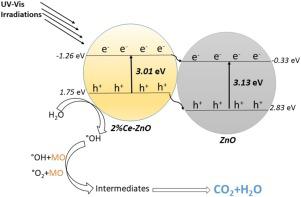Chemical Engineering Research and Design ( IF 3.7 ) Pub Date : 2021-05-17 , DOI: 10.1016/j.cherd.2021.05.008 Hanane Chaker , Alaa Eddine Attar , Mustapha Djennas , Sophie Fourmentin

|
This paper investigates a new modeling approach of central composite design (CCD) in Response Surface methodology (RSM) for the optimization of methyl orange (MO) photodegradation based to the prepared materials under UV–vis irradiation. Mesoporous zinc oxide (ZnO) have been synthesized at different cerium (Ce) contents (2, 5 and 7 wt%) through a single step sol gel method. Subsequently, cerium nanoparticles (CeNPs) have been impregnated on mesoporous ZnO. The physico-chemical characteristics of each catalyst are described through several approaches. The photocatalytic activity of the prepared catalysts shows that CeNPs enhance the photocatalytic performance of ZnO at 2 wt% Ce content. MO photodergadation processes of the optimal catalyst can be mathematically described as a function of pH-solution, catalyst dosage and MO concentration being modeled by a CCD-RSM.
Based on a statistical modeling (quadratic regression) and an optimization process (ANOVA analysis), the optimum conditions were achieved for pH of solution of 5.58, MO concentration of 20.72 mg L−1and catalyst dosage of 0.63 g L−1 which allowed reaching 100% of photodegradation. Overall, the value of the adjusted coefficient of determination (R2 = 0.9901) indicates that the considered model was quite suitable and that the selected CCD-RSM was successful in optimizing the photodegradation conditions of MO.
中文翻译:

铈掺杂介孔ZnO用于光催化降解纺织品偶氮染料的统计模型优化方法:响应表面方法的中心复合设计
本文研究了一种新的响应面法 (RSM) 中心复合设计 (CCD) 建模方法,用于优化基于紫外-可见光照射下制备的材料的甲基橙 (MO) 光降解。已经 通过一步溶胶凝胶法合成了不同铈 (Ce) 含量 (2、5 和 7 wt%) 的介孔氧化锌 (ZnO) 。随后,铈纳米颗粒(CeNPs)被浸渍在介孔氧化锌上。通过几种方法描述了每种催化剂的物理化学特性。所制备催化剂的光催化活性表明,CeNPs 在 2 重量% Ce 含量。最佳催化剂的 MO 光降解过程可以在数学上描述为 pH 溶液、催化剂剂量和 MO 浓度的函数,由 CCD-RSM 建模。
基于统计模型(二次回归)和优化过程(ANOVA 分析),溶液的 pH 值为 5.58,MO 浓度为 20.72 mg L -1和催化剂用量为 0.63 g L -1 时达到了最佳条件,可以达到100% 光降解。总体而言,调整后的决定系数值 (R 2 = 0.9901) 表明所考虑的模型非常合适,并且所选的 CCD-RSM 成功地优化了 MO 的光降解条件。











































 京公网安备 11010802027423号
京公网安备 11010802027423号